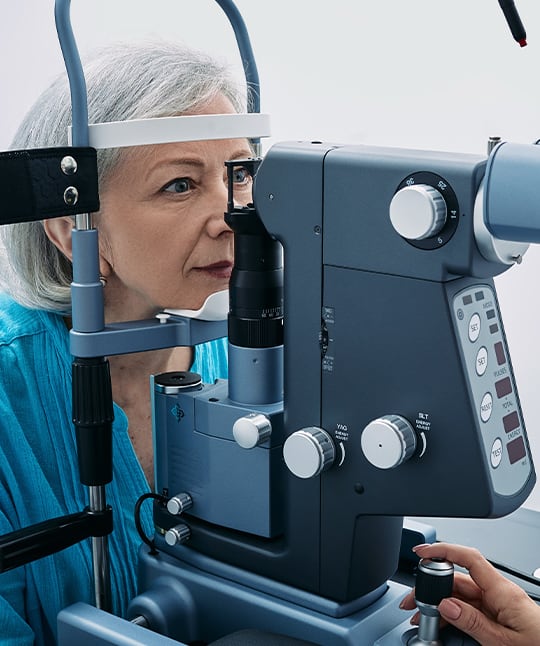Protecting Your Eyesight
Many eye diseases and conditions develop slowly, initially causing few symptoms but gradually stealing your sight. When considering your eye health, even the small stuff matters. Detecting eye problems in the early stages of development gives patients their best chance at preserving sight.
Your optometrist can monitor changes to your eye health to diagnose eye problems and prescribe solutions to support your vision. We genuinely care about your comfort and health. Talk to our team today to learn more about protecting your eyes.

Common Eye Diseases & Conditions
Your optometrist can diagnose and treat many eye conditions, from eye infections to eye injuries. While some eye conditions have obvious symptoms—such as eye irritation or blurry vision—many eye diseases have few noticeable symptoms during early development. As a result, you can experience irreversible vision loss with no warning signs.
Regular eye exams are crucial for early detection. After diagnosing your condition, we can create a personalized treatment plan to control symptoms and preserve your sight.
Some common eye diseases and conditions your optometrist can treat include:
Age-Related Macular Degeneration
Age-related macular degeneration (AMD) is the leading cause of severe vision loss in adults over 50. Aging, UV exposure, poor nutrition, and heredity are common risk factors. The disease occurs when the macula (central part of the retina) is damaged. The macula is responsible for your central vision; the vision you use to read, drive, and recognize faces.
There are 2 types of AMD:
- Dry AMD is the most common form. The macula slowly thins over time, eventually affecting vision. The formation of drusen (small, yellow deposits) under the retina can signify dry AMD.
Wet AMD is the rarer form. It occurs when abnormal blood vessels grow under the retina. The blood vessels bleed or leak fluid, causing macula thickening and swelling. Wet AMD is responsible for 90% of AMD-related blindness and should be treated as an eye emergency.
Cataracts
A cataract is a cloudy spot that develops on the eye’s normally clear lens. The cataract prevents light from easily entering the eye, causing hazy or blurry vision. Cataracts are a leading cause of blindness and low vision in the US.
Although cataracts can develop naturally due to aging, your risk can be increased by health conditions (diabetes), certain medications, and UV exposure. Early-stage vision changes can be corrected with glasses or contact lenses. Patients with later-stage development may benefit from cataract surgery.
Learn more about cataracts.
Conjunctivitis
Conjunctivitis (pink eye) is the inflammation of the conjunctiva (transparent tissue covering the white of the eye). The condition can be allergic, chemical, or infectious. Allergic and chemical conjunctivitis is not contagious. However, infectious conjunctivitis is very contagious and can be caused by bacteria, viruses, and fungi.
Treatment depends on the type of conjunctivitis. Eye drops or medications can provide relief from symptoms.
Viral conjunctivitis (a type of infectious pink eye) must run its course, much like the common cold. Your optometrist can prescribe solutions to make you more comfortable and preserve your eye health.
Diabetic Eye Disease
Diabetes is a chronic health condition that can lead to vision loss. With diabetic eye disease, high blood sugar levels can cause abnormal blood vessel growth and tissue damage. Over time, damaged blood vessels in the retina lead to vision problems, including:
- Blurry vision
- Central vision loss
- Floaters & spots
- Poor night vision
The most common form of diabetic eye disease is diabetic retinopathy. Additionally, diabetes increases your risk of developing cataracts, diabetic macular edema, and glaucoma.
Learn more about how diabetes affects eye health.
Flashes & Floaters
When flashes of light appear in your field of vision, it can indicate an eye problem. Flashes can occur in one or both eyes and have different shapes, sizes, or duration.
Several types of eye-related issues may cause flashes, ranging from harmless to eye emergencies. For example, retinal detachment may cause flashes and requires immediate treatment to save sight.
Floaters can appear as specks, threads, or various shapes floating inside your vision. However, the semi-transparent particles are trapped within the vitreous humor—the clear, jelly-like substance that maintains eye shape. The trapped protein deposits can form before birth or result from natural aging.
Most floaters are not harmful and rarely affect vision. However, certain eye diseases or injuries can increase floaters. Talk to your optometrist if you see sudden floaters—an eye exam can determine if there’s cause for concern.
Glaucoma
Glaucoma is a group of conditions that result in optic nerve damage. The progressive deterioration of the optic nerve often develops slowly, beginning with few symptoms and potentially leading to blindness. However, in the early stages, it can cause peripheral (side) vision loss.
The most common cause of glaucoma is increased eye pressure, usually related to fluid buildup. However, glaucoma can also develop in people with normal eye pressure.
Learn more about glaucoma.
Eye Nutrition
You can support your eye health and vision with eye nutrition. Look for these key vitamins and nutrients:
Essential Fatty Acids: omega-3 fatty acids support visual development and retina function; omega-3 can improve dry eye by reducing eye inflammation & supporting tear production; sources include cold-water fish (salmon, tuna).
Lutein & Zeaxanthin: may prevent light-induced damage, reducing your risk of chronic diseases. Sources include dark leafy greens and colorful fruits & vegetables.
Vitamin A: nourishes the eye and supports pigment production in the retina (necessary for seeing color). Vitamin A can also protect against childhood blindness. Sources include orange vegetables, leafy green vegetables, eggs, & cantaloupes.
Vitamin C: an antioxidant that can lower the risk of cataract development and slow the progression of age-related macular degeneration. Sources include citrus fruits, green peppers, and tomatoes.
Vitamin E: an antioxidant that protects cells from free radicals and prevents the breakdown of healthy tissue. Sources include vegetable oils, nuts, and sweet potatoes.Zinc: can relieve oxidative stress and improve immune response to reduce your risk of age-related diseases, including macular degeneration. Zinc is also essential for moving vitamin V from the liver to the retina. Sources include red meat, oysters & shellfish, nuts & seeds.
Vision Therapy
Vision therapy can help patients see more comfortably. Your optometrist creates a personalized treatment program to strengthen visual skills, such as eye coordination or visual processing.
A child with poor academic or athletic performance may be suffering from a vision problem. With a combination of techniques, patients can experience significant improvement and feel confident about their vision.Methods include eye exercises, prismatic lenses, or uniquely designed video games like Dig Rush. Talk to your optometrist to see if your child may benefit from vision therapy!
We’re Here to Help Preserve Your Vision
Many eye diseases and problems are preventable or manageable. We want to help you receive the care you deserve. Learn more ways to preserve your vision with personalized eye care at Old Town Optix Optometry.
Come See What We’re About
Our practice is located in the Old Town La Quinta shopping mall complex. Find our door to the right of the Old Town Tavern. Plenty of parking is available on the south side of the building, facing Avenida La Fonda.

Our Address
- 78015 Main St #107
- La Quinta, CA 92253
Contact Information
- Phone: 760.771.0715
- Email: [email protected]
Our Hours
- Monday: 9:00 AM – 5:00 PM
- Tuesday: 9:00 AM – 5:00 PM
- Wednesday: 9:00 AM – 5:00 PM
- Thursday: 9:00 AM – 5:00 PM
- Friday: 9:00 AM – 5:00 PM
- Saturday: 9:00 AM – 4:00 PM
- Sunday: Closed
Our Brands






Our Google Reviews
Be the First to Know,
Be the First to Win.
From eye health insights to exclusive giveaways, your feed just got a lot clearer.



